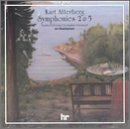| All Artists: Kurt Atterberg, Ari Rasilainen, Frankfurt Radio Symphony Orchestra Title: Kurt Atterberg: Symphonies Nos. 2 & 5 Members Wishing: 0 Total Copies: 0 Label: Cpo Records Original Release Date: 1/1/2002 Re-Release Date: 5/21/2002 Genre: Classical Styles: Historical Periods, Modern, 20th, & 21st Century, Symphonies Number of Discs: 1 SwapaCD Credits: 1 UPC: 761203956524 |
Search - Kurt Atterberg, Ari Rasilainen, Frankfurt Radio Symphony Orchestra :: Kurt Atterberg: Symphonies Nos. 2 & 5
 | Kurt Atterberg, Ari Rasilainen, Frankfurt Radio Symphony Orchestra Kurt Atterberg: Symphonies Nos. 2 & 5 Genre: Classical |
Larger Image |
CD DetailsSimilarly Requested CDs
|
CD ReviewsA Compelling, Poetic Second & the Dramatic, Funereal Fifth. David A. Hollingsworth | Washington, DC USA | 05/26/2002 (5 out of 5 stars) "The Second Symphony of (1911-1913) is truly an impressive piece, highly engaging yet serious in its purpose as if Atterberg was under a tutelage of Bruckner (or of Glazunov). It starts off with such an euphonious sense of nobility and freshness, with the ensuing development that is convincingly majestic and epic remotely Glazunovian in vein (especially towards the end). Then turn to the highly thematically inventive second movement and you'll see again that sense of magic and mystery that even Bax would have appreciate. But the faster middle sections are sweeping and vivid and the ending is as triumphant as a Bruckner. The finale is quite captivating also, and although the ideas threaten to run thin a bit, Atterberg use of the materials from the previous movements give the finale a more sense of purpose and chemistry. But notice the Glazunovian-type rhetoric at, say 2'02"-ff and at the coda and the appealing nature of the movement is even more apparent. The critics were right in pressuring him to compose the third movement (the composer, understandably, was content in the original two-movement version). In essence, this is truly a memorable listening experience.Atterberg's Fifth Symphony of 1922 "Sinfonia Funebre" is very much in a different league, though again very serious in purpose. Written in the same period as Nielsen's Fifth, Bax's First, & Myaskovsky's Sixth, Atterberg's Fifth shares with them the feeling of tormentation and yearning lamentations due to the upheavals that occupied much of the world and Europe (the First World War, the Easter Uprising in Ireland, the Russian Revolution and Civil War, etc.). Atterberg's work is as personal as, say, Myaskovsky's and Bax's, and to a large extent, Nielsen's. The Symphony, in three continuous movements, embodies the mood that is bleak and defiant, passionate, epic, and angered in particularly the first two movements. The memorable lento, second movement, is very much funereal in temperament, with the poignancy of sadness and mournfulness that's as profound as ever (something Allan Pettersson could relate to). That poignancy becomes more compelling @ 7'50' -ff. The finales of Nielsen's and Bax's Symphonies are hopeful, optimistic, and ultimately inspirational, while the finale of Myaskovsky's alternates in feeling (between the uplifting and lamentation, with the ending contemplative in nature). The finale of Atterberg's is very such like that of Myaskovsky's, incidentally, with the mood somewhat uplifting and deviant, though there are places, especially @4'09' and towards the end, where the sombre mood of the lento movement reappears. The valse has this menacing, macabre feeling to it that at one point has a bit too much of a ballroom dance for my liking (and for a moment, the profound depth and substance of the previously movements and the first several minutes of the finale are forgotten). But Atterberg compensates that with the troubled poignancy of the previous movements at the finishing bars of the work, with the atmosphere very glooming and elegiac in outlook. Although the Symphony is not a masterpiece as Nielsen's and Myaskovsky's, it shall be counted as among his strongest works. Ari Rasilainen draws both sympathetic and forceful performances from the Radio Symphony Orchestra of Frankfurt and his approach is of real flair and genuinity. And while I would not replace my Swedish Society CD of Atterberg's Second Symphony and the Third Suite for strings, viola, and violin (of real beauty and eloquence) rendered wonderfully & idiomatically by Stig Westerberg and the Swedish Radio Symphony, this CD is a must get. As usual, the booklet notes and recording are first class and exemplary. I await, with some excitement, the next installments!"
|









